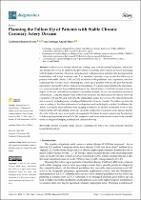| dc.contributor | Vall d'Hebron Barcelona Hospital Campus |
| dc.contributor.author | Romero Farina, Jorge Guillermo |
| dc.contributor.author | Aguade Bruix, Santiago |
| dc.date.accessioned | 2022-05-02T12:04:03Z |
| dc.date.available | 2022-05-02T12:04:03Z |
| dc.date.issued | 2021-10 |
| dc.identifier.citation | Romero-Farina G, Aguadé-Bruix S. Planning the Follow-Up of Patients with Stable Chronic Coronary Artery Disease. Diagnostics. 2021 Oct;11(10):1762. |
| dc.identifier.issn | 2075-4418 |
| dc.identifier.uri | https://hdl.handle.net/11351/7420 |
| dc.description | Chronic coronary artery disease; Longitudinal analysis; Planning the follow-up |
| dc.description.abstract | Cardiovascular disease remains the leading cause of death among Europeans, Americans, and around the world. In addition, the prevalence of coronary artery disease (CAD) is increasing, with the highest number of hospital visits, hospital readmissions for patients with decompensated heart failure, and a high economic cost. It is, therefore, a priority to try to plan the follow-up of patients with stable chronic CAD (scCAD) in relation to the published data, experience, and new technology that we have today. Planning the follow-up of patients with scCAD goes beyond the information provided by clinical management guidelines. It requires understanding the importance of a cross-sectional and longitudinal analysis in the clinical history of scCAD, because it has an impact on the cost of healthcare in relation to mortality, economic factors, and the burden of medical consultations. Using the data provided in this work facilitates and standardizes the clinical follow-up of patients with scCAD, and following the marked line makes the work for the clinical physician much easier, by including most clinical possibilities and actions to consider. The follow-up intervals vary according to the clinical situation of each patient and can be highly variable. In addition, the ability to properly study patients with imaging techniques, to stratify at different levels of risk, helps plan the intervals during follow-up. Given the complexity of coronary artery disease and the diversity of clinical cases, more studies are required in the future focused on improving the planning of follow-up for patients with scCAD. The perspective and future direction are related to the valuable utility of integrated imaging techniques in clinical follow-up. |
| dc.language.iso | eng |
| dc.publisher | MDPI |
| dc.relation.ispartofseries | Diagnostics;11(10) |
| dc.rights | Attribution 4.0 International |
| dc.rights.uri | http://creativecommons.org/licenses/by/4.0/ |
| dc.source | Scientia |
| dc.subject | Sistema cardiovascular - Malalties - Imatgeria |
| dc.subject | Imatgeria per al diagnòstic - Tècniques digitals |
| dc.subject.mesh | Follow-Up Studies |
| dc.subject.mesh | Cardiovascular Diseases |
| dc.subject.mesh | /diagnostic imaging |
| dc.title | Planning the Follow-Up of Patients with Stable Chronic Coronary Artery Disease |
| dc.type | info:eu-repo/semantics/article |
| dc.identifier.doi | 10.3390/diagnostics11101762 |
| dc.subject.decs | estudios de seguimiento |
| dc.subject.decs | enfermedades cardiovasculares |
| dc.subject.decs | /diagnóstico por imagen |
| dc.relation.publishversion | https://doi.org/10.3390/diagnostics11101762 |
| dc.type.version | info:eu-repo/semantics/publishedVersion |
| dc.audience | Professionals |
| dc.contributor.organismes | Institut Català de la Salut |
| dc.contributor.authoraffiliation | [Romero-Farina G] Servei de Cardiologia, Vall d’Hebron Hospital Universitari, Barcelona, Spain. Vall d’Hebron Institut de Recerca (VHIR), Barcelona, Spain. CIBERCV, Universitat Autònoma de Barcelona, Bellaterra, Spain. [Aguadé-Bruix S] Servei de Medicina Nuclear, Vall d’Hebron Hospital Universitari, Barcelona, Spain. Vall d’Hebron Institut de Recerca (VHIR), Barcelona, Spain. CIBERCV, Universitat Autònoma de Barcelona, Bellaterra, Spain |
| dc.identifier.pmid | 34679460 |
| dc.identifier.wos | 000717104100001 |
| dc.rights.accessrights | info:eu-repo/semantics/openAccess |

